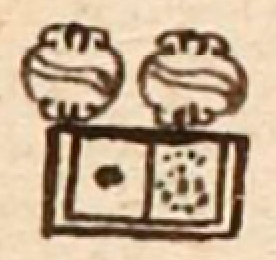Tlaltetecuin (Verg12r)
This black-line drawing of the compound glyph for the personal name Tlaltetecuin (“Earth Stomper" or "Earth Pounder," attested here as a man’s name) shows a bird's eye view of a bordered, rectangular piece of land (tlalli) divided into two parcels or segments. The segment on the left has one large round dot, and the one on the right has many small dots (suggesting cultivation). Above the rectangular land element are two horizontal stones, with their curling ends both upward and downward. Across the middle of each stone are parallel, wavy, horizontal lines. These stones (tetl) provide the phonetic value and visual reduplication for the "-tete-" part of the name, which is alphabetically reduplicated, as shown in the gloss. Tetecuini is a verb meaning to pound, which the stones support both phonetically and semantically.
Stephanie Wood
Tlaltetecuin is also the name of a divine or sacred force or deity, the Earth Pounder. Tlaltetecuin and Ixtlilton were related deities associated with medicine and dances that bring health, but also with the communication between humans and the divine world. For more information, see Katarzyna Mikulska, Tejiendo Destinos (2015). Might earth pounding have something to do with earthquakes? Or might an Earth stomper be a dancer? Or perhaps one who is tamping down the ground after seeding it? Assistance with the interpretation of this glyph and the deity name would be appreciated.
Stephanie Wood
juan tlaltetecui
Juan Tlaltetecuin
Stephanie Wood
1539
Jeff Haskett-Wood
tierras, parcelas, piedras, golpear

tlal(li), land parcel, https://nahuatl.wired-humanities.org/content/tlalli
tetecuini, to pound, https://nahuatl.wired-humanities.org/content/tetecuini
Tlaltetecuin, name of a deity, https://nahuatl.wired-humanities.org/content/tlaltetecuin
Tierra Golpeada
Stephanie Wood
Codex Vergara, folio 12r, https://gallica.bnf.fr/ark:/12148/btv1b84528032/f31.item.zoom
The non-commercial reuse of images from the Bibliothèque nationale de France is free as long as the user is in compliance with the legislation in force and provides the citation: “Source gallica.bnf.fr / Bibliothèque nationale de France” or “Source gallica.bnf.fr / BnF.” We would also appreciate a citation to the Visual Lexicon of Aztec Hieroglyphs, https://aztecglyphs.wired-humanities.org/.









